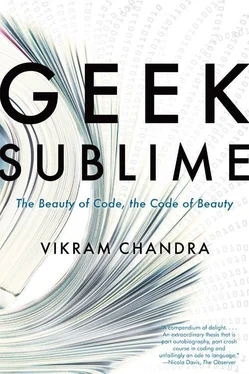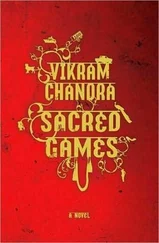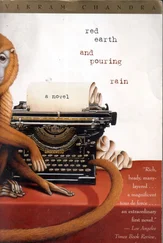So the experience of the writer during samadhi is more akin to the mental state “(laboriously) milked by yogin” than it is to the effortlessly achieved rasa of the sahrdaya. The yogin know well these beautiful, bleak landscapes of our inner worlds. I once heard the scholar, Tantric practitioner and teacher Paul Muller-Ortega speak about the terrors the yogi faces on the path toward self-realization. Yogic practices didn’t just bring bliss or pleasure, he said. The “yogic ordeal” also made you feel that “you are dying.” And this was true, Muller-Ortega said. “You are dying.” That is, the ego-self that most of us believe to be our true self must die if the identification with the larger, undivided self is to occur. The yogi must confront the mysterium tremendum and pass through it. The path of the yogi is not for the faint-hearted.
The sahrdaya , on the other hand, is granted the spontaneous, temporary suspension of the ego-self through the encounter with art, while tasting — in a concentrated, wondrous manner — consciousness itself, the larger self of the world. The Natyashastra tells us that theater was created by Brahma as a fifth Veda, available to people of all castes and conditions; art is thus a democratic meditation through which the ordinary person can taste bliss.
In a sustained act of attention, the sahrdaya absorbs the foreign substance of another’s language into her body, mind, and spirit; the form of the language and the sphota , the explosion of its meaning, take shape within her single-pointed concentration and the heat of her imagination; the dhvani or reverberation of this encounter causes an instantaneous, infinite cognition of memory-elements that dissolve into the story or poem, bringing it to life. This melting of the heart is a transfiguration which deploys the body and desire and mind: both the sahrydaya and the Tantric cry out, camatkara, camatkara! And both, if they practice enough, risk enough, will experience an expansion of the imagination and thus be transformed by this praxis of pleasure.
Is the writer then a kind of entry-level yogi, engaging in a daily practice that mingles asceticism, dangerous mental disciplines, multifarious cognitive states, suffering and joy? There have been many figurings of the artist in recent history: Romantic seeker-explorer, drunken hedonist, bohemian outcast, manic depressive, social reformer, truth teller, tortured confessor of secrets. Perhaps it would be apposite to set next to these a portrait offered by Madhuraja, Abhinavagupta’s contemporary and student:
[Abhinavagupta] sits in the middle of a garden of grapes, inside a pavilion made of crystal and filled with beautiful paintings. The room smells wonderful because of flower garlands, incense-sticks and (oil-) lamps … The room is constantly resounding with musical instruments, with songs and with dancing … Abhinavagupta is attended by all his numerous students, with Kṣemaraja at their head, who are writing down everything he says. To his side stand two women, partners in Tantric rites ( dūtī ), who hold in one hand a jug of wine, śivaraasa , and a box full of betel rolls, and in the other hand a lotus and a citron. Abhinavagupta has his eyes trembling in ecstasy. In the middle of his forehead is a conspicuous tilaka made of ashes … His long hair is held by a garland of flowers. He has a long beard and golden (reddish-brown) skin; his neck is dark with shining yakṣaparīka powder … he sits in the Yogic position known as virāsana [the pose of the hero]. One hand is held on his knee holding a rosary with his fingers clearly making the sign ( mudrā ) that signifies his knowledge of the highest Siva. He plays on his resonating lute with the tips of his quivering fingers. 30
In recent decades there has been something of an Abhinavagupta revival, an increasing interest — in India and elsewhere — in his work. This is due, in no small part, to a fascination with the person one glimpses in the texts — with the sheer range of knowledge, the confident voice, the subtlety of the mind; his contemporaries regarded him as “Shiva incarnate,” and one feels the glamour across the centuries. As often happens with culture heroes, his life shades off into legend: around 1025 CE, he and 1,200 followers are said to have entered a cave, singing a hymn Abhinavagupta wrote to Bhairava (the terrifying manifestation of Shiva); none of them were seen again. We have twenty-one of the books he wrote, and know of twenty-three other now-lost titles. 1His grand masterwork, the Tantraloka , has been translated into Hindi and Italian, but still awaits an authoritative and complete translation into English. “Abhinavagupta Studies” is a fast-expanding field because much remains to be done.

Efforts to restore Sanskrit to some semblance of its former glory are afoot. At the time of this writing, a nonprofit group based in Bangalore, Samskrita Bharati, has begun the task of translating the Amar Chitra Katha comics into Sanskrit. 2The organization’s slogan is, “Revive a language. Rejuvenate a culture. Revolutionize the world.”
Something of the same wide-ranging cultural aspiration fuels some governmental attempts to bolster the teaching of Sanskrit. In 2010, the BJP-led Uttarakhand state government proclaimed two villages to be “Sanskrit Villages,” which meant that funding was provided to teach all citizens — including Dalits — the language. Uttarakhand has “a separate Sanskrit Education Department, 88 government-aided Sanskrit educational institutes, and 47 Sanskrit colleges giving ‘Shastri (BA)’ and ‘Acharya (MA)’ degrees.” But in one of the villages, “people learnt to speak the language with much hope and now wait in vain for the gains that were to follow.” 3The Congress government that followed dropped the project, so the villagers’ ambitions of being appointed Sanskrit teachers for other villages remain frustrated.
The Special Centre for Sanskrit Studies at the Jawaharlal Nehru University in New Delhi has more explicit aims: Sanskrit computational linguistics, Sanskrit informatics, Sanskrit computing, Sanskrit language processing. There has also been an effort over the past two decades to reintroduce the Indian scholastic tradition into humanities departments, and students have responded with enthusiasm. Controversies have flared over some of the more clumsy attempts by academic nationalists to proclaim — by fiat — the continuing relevance and accuracy of “Vedic astrological science” and similar subjects. Sanskrit departments are still Brahminical redoubts, within which Dalit students face active prejudice.
In 2004, the Department of Posts released a postage stamp honouring Panini, in the denomination of Rs 5.

After Abhinavagupta, rasa-dhvani theory became the predominant system of aesthetic analysis in the subcontinent, although it was by no means accepted universally. Many poets wrote poetry that displayed astonishing technical virtuosity rather than depths of dhvani ; the great Anandavardhana himself, despite his stern pronouncements about “picture poetry,” wrote a spectacular picture poem called the “Devisataka” (The goddess’s century) which when decoded syllabically according to the embedded instructions reveals an intricate, spoked wheel. He explains in the poem that the goddess appeared in a dream and not only told him to write the poem but also acted as his instructor.
Читать дальше













